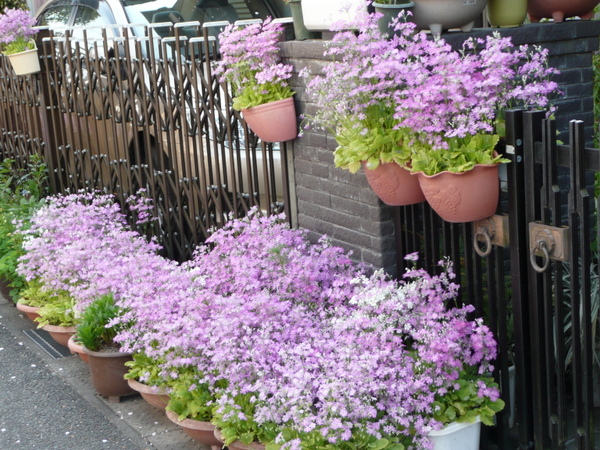Growing primula
Soil
All the primulas we list do best in neutral or slightly acid soil. They like a partially shaded position and large quantities of organic matter.
Primroses and Polyanthus
Barnhaven primroses and polyanthus are bred to be hardy and tolerant of a wide range of conditions, but they are descended from woodlanders and are happiest in humus-rich, well-drained soil which does not dry out. The ideal location for them would be on a slope under deciduous trees, - or in a north-east facing bed. Full sun on frozen foliage, alternating freeze / thaw conditions, waterlogging in winter, or hot dry conditions in summer will all punish the plants. If you get a lot of freezing, a loose covering of leaves or straw will help. Dividing the plants every two or three years helps also, and is a must for the doubles. For best results, feed the plants with a weak solution of high potash or tomato fertiliser every ten days from the time the buds start to form until the first flowers open. A 'thank you' feed when flowering ends is recommended, but don't feed late in the season and don't use a high nitrogen fertiliser.
Double Primroses
They require the same conditions as the polyanthus and primroses described above, but a little extra kindness will be repaid. Doubles don't have the ability to set seed, but the plant will keep producing blooms in an effort to do so, - sometimes as many as a hundred!! This exhausts the plant and they need to be helped with extra feeding and watering. Picking some of the blooms also helps - they keep well in water. Some organic manure with a higher nitrogen content is welcome, and moisture must be watched during dry periods in the summer. Because no seed is set , old blooms linger on the plant and can cause rot in the crown. Watch out for rot / botrytis and spray if there is any sign of it. Divide the plants every two years to keep them vigorous.
Primula sieboldii
Sieboldii are woodlanders also, but cannot tolerate lime. They like dappled shade under deciduous trees, with humus-rich, moist, well-drained soil. They form large root clumps so they need space. Their leaves begin to die down in August, so mark their position. while there may be little evidence of the plant above ground, the root structure is alive and well and working for next year below the surface. A top-dressing of an alkaline -free compost helps. They are also often grown as pot plants in Japan, and grow very well in well-drained compost that shouldn't be allowed to dry out. Simply place them in a shaded place in the garden when they have finished flowering and divide them every couple of years, discarding the centre part of the plant which is usually rotting away.
© Anne-Marie Leroy, Photo taken in Japan en 2012.
Candelabras
Candelabras are easy to grow but must be maintained in nutritious moist soil throughout the growing season. They are ideal for a bog garden in full sun, - or a damp spot beside a stream. They also do well in groups in acid beds used for rhododendrons or azaleas. They lose their leaves in winter and self- sow profusely.
Primula florindae
Florindae can grow up to five feet high and the same across in good conditions. They are not really plants for the small garden. They do best in a nutrient -rich bog garden and die down in the winter. They self-sow quite easily and will hybridise with Primula sikkimensis, waltonii and alpicola.
Primula denticulata
The drum-head primula is easy to grow on most garden soils but likes a little moisture and humus. Slugs will eat the centre bud during the winter if they are allowed. It seeds easily but the colours of the offspring are usually duller than good parent colours. After flowering, the leaves become quite large, so make sure to allow enough space to avoid swamping more delicate plants. Divide every couple of years.
Primula capitata
Easy to grow in standard primula conditions. Plants are short-lived, but a small group will set seed and renew itself.
Primula allionii
P.allionii are generally grown in an alpine house. A gritty compost is recommended, with a top dressing of limestone chips to keep the neck of the plant from going soggy. Mostly happiest in shallow pans, but don’t overpot. Summer: keep as cool and airy as possible, and water just enough. Autumn : restrict watering and watch for fungal attack. Winter: remove dead and decaying leaves and keep fairly dry. Spring: enjoy, give some gentle feeding and remove dead flowers after flowering. A good time to re-pot.
Primula marginata
P.marginata are very hardy. With good drainage they grow well in a trough, crevice or rock garden but for their full glory to be appreciated they are often grown in a cold greenhouse where the beautiful farina on their leaves is protected from the rain. Seasonal care as above.

